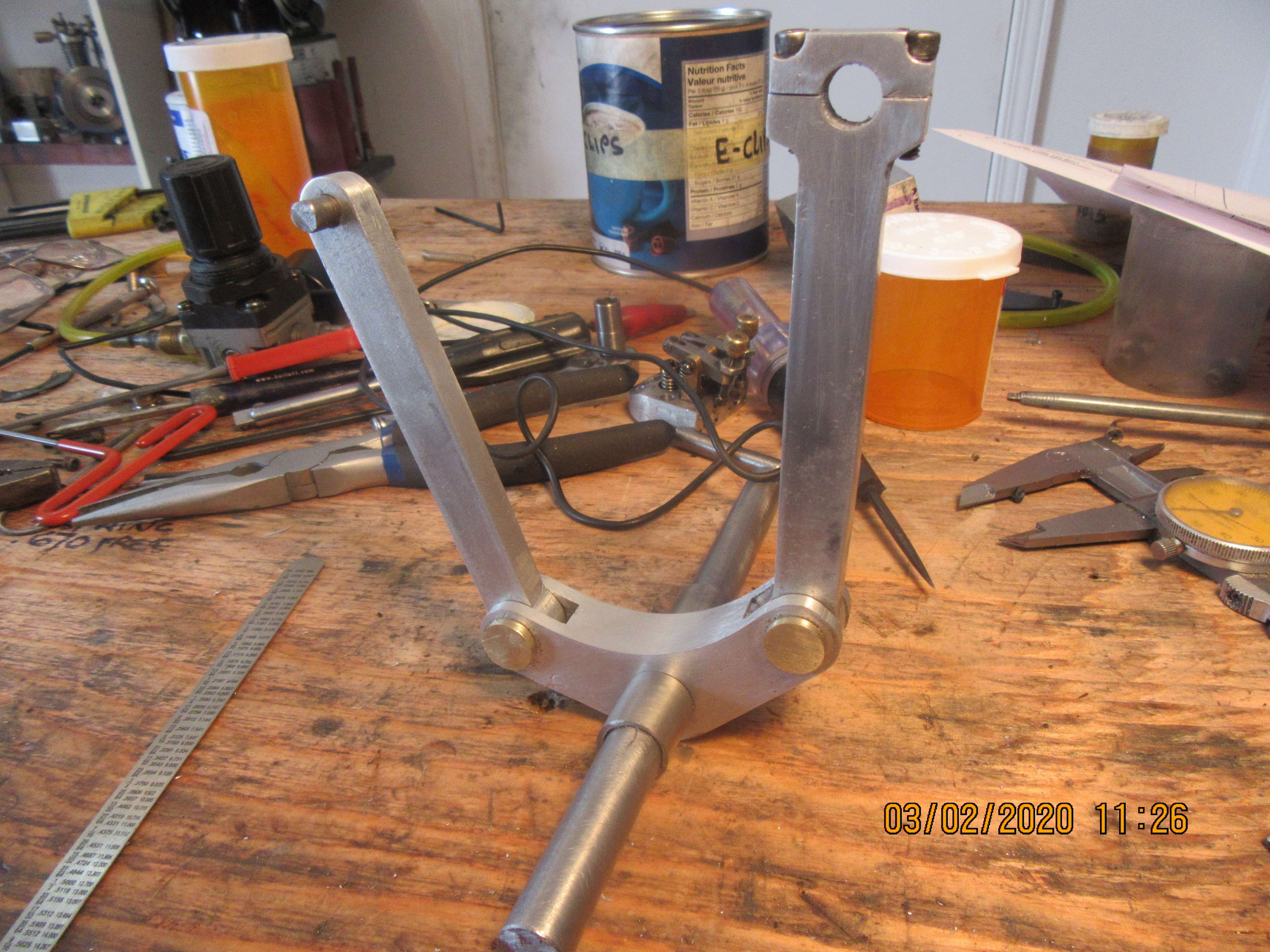You are using an out of date browser. It may not display this or other websites correctly.
You should upgrade or use an alternative browser.
You should upgrade or use an alternative browser.
A different engine configuration
- Thread starter Brian Rupnow
- Start date

Help Support Home Model Engine Machinist Forum:
This site may earn a commission from merchant affiliate
links, including eBay, Amazon, and others.
And what's better than having one connecting rod?---Well of course, it's having two connecting rods. Now I have to go and chase down bearings and plates.


Apprentice707
Well-Known Member
Didn't Commer have a lorry engine with these in the '50s? I think it was a 6 cylinder and a flat configuration. Might not be right I was only 10 and more interested in bicycles.
Cheers
B
Cheers
B
My Bad--I posted the last entry in the wrong thread. After much work and many failed attempts to run the "throttle governed engine" I have reached a conclusion. There were no real flaws in the self governing mechanism. The flaw was that I couldn't get the basic engine to run properly. The new cylinder heads with the sparkplugs moved didn't really help. The ignition cam on this engine mounts onto the crankshaft. The crankshaft rides on bronze bushings that have rapidly worn out, due to the crankshaft not being perfectly true with no runout. The slop in the crankshaft bearing lets the crank move around enough to screw up the gap in the ignition points. I have put the engine up on the shelf, and at a later date I will remake the main crankcase and design it so the crankshaft and camshaft both ride on sealed roller bearings. Sealed ball bearings, surprisingly, will tolerate a bit of run-out in the crankshaft, and are not harmed by this.
- Joined
- Dec 16, 2013
- Messages
- 29
- Reaction score
- 15
Rootes group trading name was Commer and they made a turbo charged 3 cylinder engine with 6 pistons, about 105 horse power and torque out put of some thing like 270 lb.ft at 1200 rpm. It was known as TS3 but in every day language it was called a Commer Knocker, they were popular in road transport in Australia as vehicle registration was calculated by the number of cylinders the vehicles engine had. I drove trucks with this engine in the 1960's, believe it or not they were also used in semi trailers on interstate transport. Un-believably under powered and on a good day with a gross mass in the 20/ 22 ton range you'd be very lucky to exceed a top speed of 35 miles an hour, that's if you ever got into top gear. Even a slight head wind or in undulating country would see the truck down to 2 nd gear in the gear box and low in the two speed axle. Although I never found a hill on the highway it couldn't climb. An interesting thing is that at night when struggling against a head wind or going up hill there was a long flame and sparks coming out the exhaust, being Australia it was quite common to have a spark arrester in the tailpipe. The closest capital cities in Australia is Adelaide --- Melbourne at around 460 miles, can you imagine the hours you needed to stay awake to physically load and unload and do the return trip. No sleeper cabs in those days, when your eyes wouldn't stay open you'd put a cushion or rolled up blanket on the steering wheel and get a couple hours sleep. As we were paid trip money to make a weeks wages you'd need to do at least 2 return trips a week. That considered I spent most of my working life as a truck driver.Didn't Commer have a lorry engine with these in the '50s? I think it was a 6 cylinder and a flat configuration. Might not be right I was only 10 and more interested in bicycles.
Cheers
B
Apprentice707
Well-Known Member
I seem to remember the lorry was actually a Karrier Bantam tipper on which my father delivered small loads of aggregates to customers, it was green and I have driven it in his driveway and yard. I was too young to drive on the road. We lived in a hilly part of Derbyshire and I don't remember it having any problems.
Cheers
B
Cheers
B

$29.95
Competition Engine Building: Advanced Engine Design and Assembly Techniques (Pro Series)
Amazon.com Services LLC
![DreamPlan Home Design and Landscaping Software Free for Windows [PC Download]](https://m.media-amazon.com/images/I/51kvZH2dVLL._SL500_.jpg)
$0.00
DreamPlan Home Design and Landscaping Software Free for Windows [PC Download]
Amazon.com Services LLC

$40.02
$49.99
Becker CAD 12 3D - professional CAD software for 2D + 3D design and modelling - for 3 PCs - 100% compatible with AutoCAD
momox Shop

$24.99
$34.99
Bowl Sander Tool Kit w/Dual Bearing Head & Hardwood Handle | 42PC Wood Sander Set | 2" Hook & Loop Sanding Disc Sandpaper Assortment | 1/4" Mandrel Bowl Sander for Woodturning | Wood Lathe Tools
Peachtree Woodworking Supply Inc
Similar threads
- Replies
- 7
- Views
- 592
- Replies
- 22
- Views
- 2K
- Replies
- 95
- Views
- 12K
























